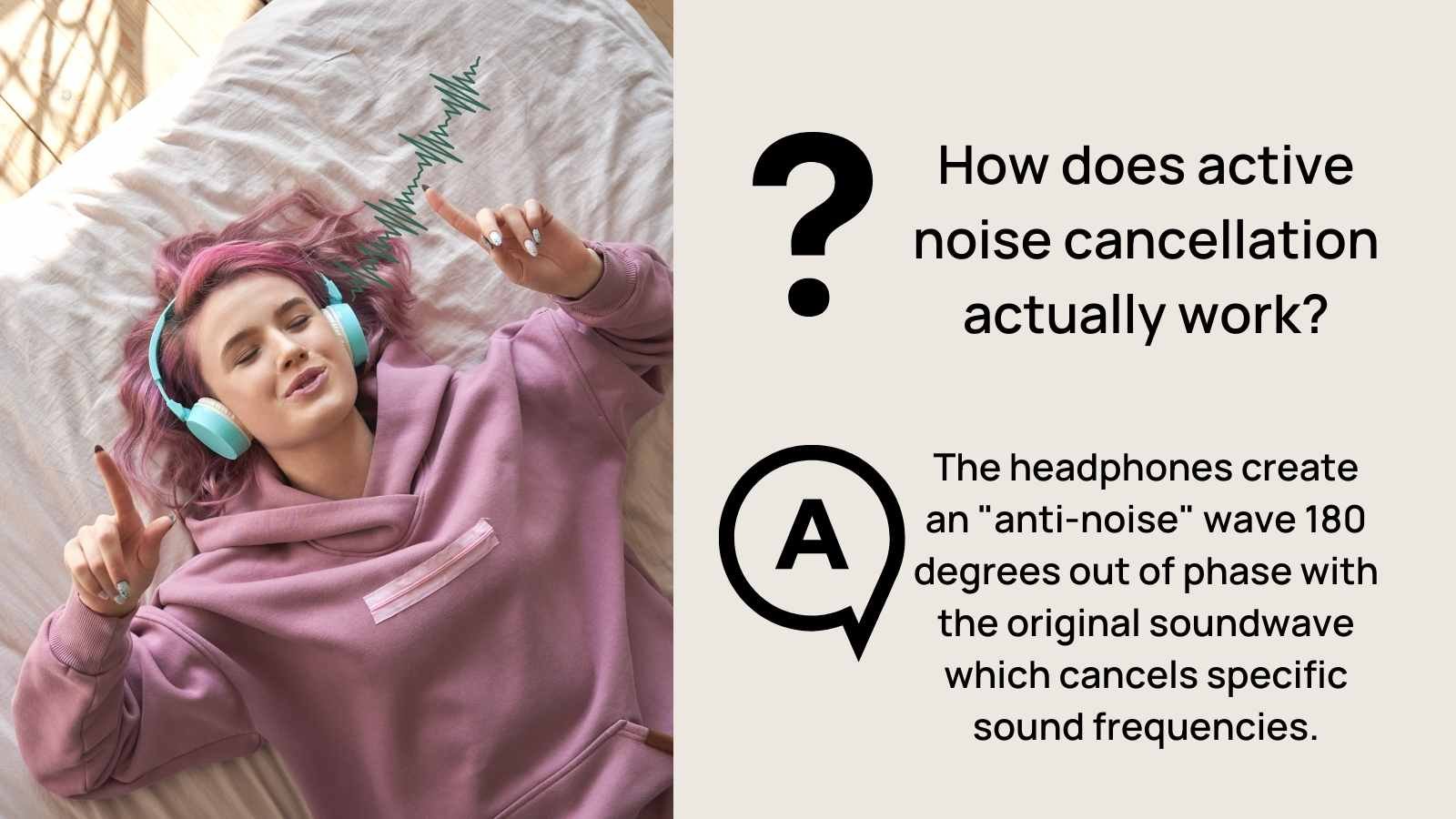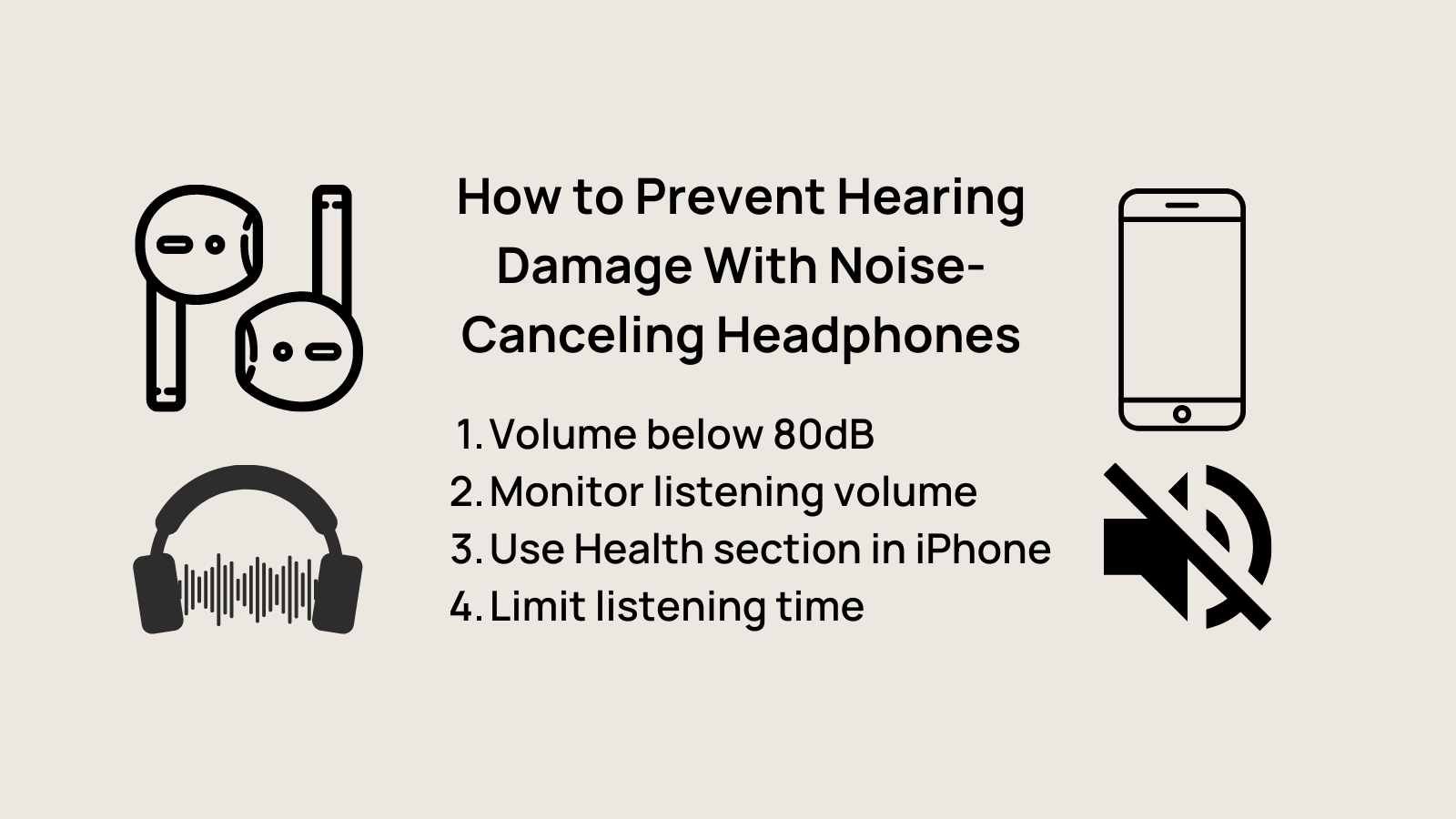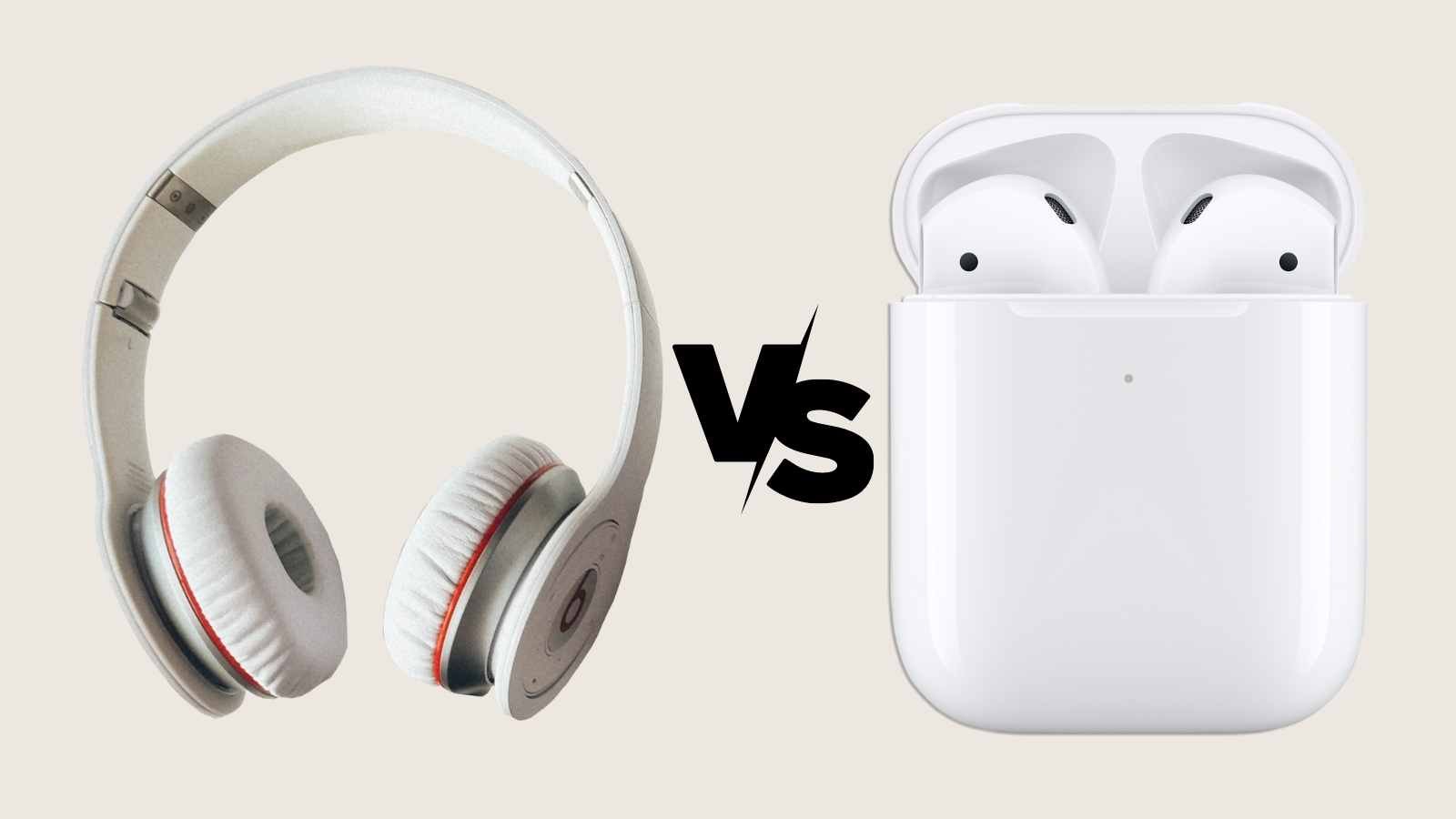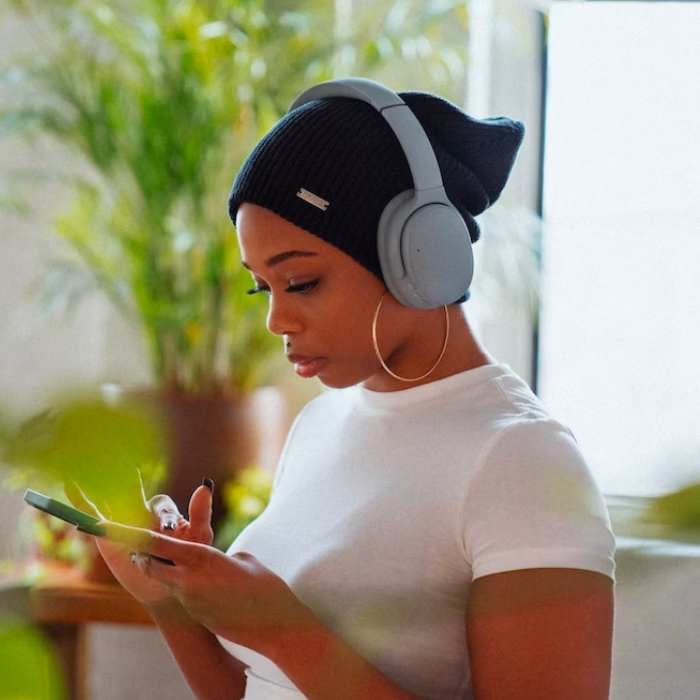Many of us rely on noise-canceling headphones for peace in noisy environments, but you might wonder if this technology can hurt your hearing.
The short answer is no – in fact, active noise cancellation (ANC) can be beneficial to your hearing when used responsibly.
Below, we’ll explain how ANC works, why it isn’t harmful, and how it can even help protect your ears by letting you listen at lower volumes.
We’ll also share some tips for safe listening and a quick way to test your hearing health.
Prefer to watch?
Here's a quick video breakdown.
.png)
Key Takeaways:
- As the FDA does not regulate headphone volume, it’s up to us to self-regulate our listening volume.
- Noise canceling headphones can help keep your volume within a safe range, so you don’t have to crank up volume to hear ‘over’ the noise.
- And while over-the-ear headphones can help close off more outside noise (than earbuds), it’s still important to keep the maximum volume at 70% or less to maintain hearing health.
How Does Active Noise Cancellation (ANC) Work?

Active Noise Cancellation reduces unwanted background sound by adding a second sound that cancels out the noise. It works by:
- Microphones detect ambient noise: ANC headphones have tiny microphones that pick up the sounds around you.
- “Anti-noise” is generated: The headphone’s electronics instantly create an inverse sound wave (equal in amplitude but opposite in phase) to neutralize the incoming noise.
- Noise is canceled out: When the inverse wave meets the incoming noise wave, the two effectively cancel each other out, reducing the volume of the ambient sound before it reaches your ears. (Think of it like adding +1 and -1 – they sum to 0, or in this case, silence.)
- This noise-canceling process happens continuously and very fast (modern ANC systems sample and adjust to noise hundreds of times per second) to hush steady sounds like engine rumble or air conditioner buzz [1].
The result: a quieter listening experience. You hear more of your music or podcast, and less of the jet engine or crowd around you.
Are Noise-Canceling Headphones Safe for Your Hearing?
- No inherent harm: Using ANC does not damage your hearing. The technology doesn’t produce any harmful noise; it actually reduces the overall noise reaching your eardrums. Several studies have shown that noise-cancelling headphones are absolutely safe and pose no significant health risks. In other words, ANC itself won’t hurt your ears.
- Myth of “ear pressure”: Some people notice a slight pressure sensation when they first turn on noise cancellation. This isn’t dangerous – it’s just the absence of low-frequency sound that your ears are noticing. Our ears are used to a bit of background rumble, so when ANC removes it, it can feel similar to the pressure change you experience in an airplane cabin. Importantly, there’s no actual pressure being applied to your eardrum, and experts have found no evidence that this sensation causes any physical harm. If the feeling is uncomfortable, you can always use a lower ANC setting or take short breaks, but rest assured the sensation is not damaging your ears [2].
- ANC vs. loud volume: The biggest risk to your hearing from headphones isn’t the ANC technology – it’s high volume. Blasting any headphones at too loud a volume for too long can cause noise-induced hearing loss or ringing in the ears (tinnitus). Noise-canceling models can actually help you avoid this problem by making the environment quieter, so you don’t feel the need to crank up the sound. Anything below 80 decibels is typically considered safe, so keeping your headphone volume reasonable (and not maxed out for hours) is key. ANC helps you do that by lowering the background noise floor.
- Expert consensus: Audiologists generally agree that ANC headphones used responsibly are no more dangerous than regular headphones. The “anti-noise” they produce cancels out ambient sound instead of adding to it, which means less sound overall hits your ears. One scientific review found no evidence of hearing damage directly caused by ANC; in fact, it suggested that by allowing users to listen at lower volumes, noise-canceling headphones might actually contribute to hearing preservation. In short, the technology itself is sound (no pun intended) from a hearing health perspective [3].
- Stay aware of surroundings: One caution unrelated to ear health is that blocking out noise can reduce your awareness of what’s happening around you. For example, you might not hear car horns, people talking to you, or alarms while you have ANC on. This isn’t a threat to your hearing, but it can be a safety concern. Use common sense: in situations where you need to stay alert (like walking on busy streets or biking), consider using a transparency mode (if your headphones have one) or leaving one earbud out so you can hear important sounds.
How Noise Cancellation Can Protect Your Hearing
Noise-cancelling headphones can actually be a helpful tool for preserving your hearing in noisy environments. Here’s how:
- Lower volume = safer listening: By reducing background noise, ANC headphones let you enjoy your audio at a lower volume and still hear it clearly. You don’t have to turn the volume up to compete with external noise. For instance, instead of maxing out your music on a plane to drown out engine roar, you can keep it at a comfortable level because the roar is already hushed. Listening at safer, lower volumes means less risk of noise-induced hearing loss over time. In fact, if you’re in a loud environment, using noise-canceling headphones to block out background noise can reduce the temptation to crank up the volume, helping prevent noise-induced hearing loss.
- Prevents “volume creep”: Have you ever found yourself raising the volume little by little because the area around you got noisier? Noise-canceling can stop this volume creep. By keeping the environment quiet, you won’t be as tempted to raise the sound over time. Your ears get a quieter backdrop, which means you can listen comfortably without putting as much stress on your hearing.
Tips for Safe Listening with Noise-Canceling Headphones

To get the most benefit from ANC headphones (and any headphones) while keeping your ears safe, follow these tips:
- Keep volume moderate: Even though ANC helps reduce background noise, you should still listen at a reasonable volume. Audiologists recommend aiming for around 60% of your device’s maximum volume, which typically keeps you in a safe range (around 65–80 dB). Some phones and music apps will warn you if you raise the volume to risky levels – pay attention to those cues.
- Follow the 60/60 rule: A popular guideline to protect your ears is the “60/60 rule” – listen at no more than 60% volume for no more than 60 minutes at a time. After about an hour of continuous listening, give your ears a break (even if it’s just for a few minutes) before resuming. This rule helps limit both the volume and the duration of exposure, which are the two factors that determine noise-induced damage.
- Take regular breaks: Your ears benefit from periodic quiet time. Even with noise-canceling headphones, it’s smart to take them off now and then and enjoy some silence or quiet background sounds. For example, if you’ve been using headphones for a long work session or a multi-hour flight, take a break every hour or so to let your ears rest. Prolonged use without breaks, especially at higher volumes, can fatigue your ears. Giving your hearing a rest helps prevent that “full ear” feeling and any temporary threshold shifts (short-term reduction in hearing sensitivity) that come from extended listening.
- Use a good fit: ANC works best when your headphones fit well. If you have earbuds, try the different ear tip sizes to form a good seal; if you have over-ear headphones, ensure the ear cups fully cover your ears without gaps. A snug fit provides passive noise isolation (blocking noise just by physically covering your ear) and improves the effectiveness of the active cancellation. This means the headphones can cancel noise more efficiently, and you won’t be tempted to raise the volume to compensate for sound leaks.
By following these practices, you can enjoy the benefits of noise-cancelling headphones and minimize any risks. The goal is to enjoy your music, podcasts, or calls without putting stress on your hearing.
Are over ear headphones better or worse for hearing damage than earbuds?

The fact of the matter is that both headphones or earbuds can be a good option.
If you’re looking for a more solid noise-reduction option, over-the-ear headphones—especially circumaural headphones—are just the thing. This is because these headphones are bulkier but can seal off the ear better, allowing for more significant attenuation of ambient noise.
So what does that mean for a headphone wearer? To start, it will be easier to listen at a safer volume.
Earbuds with noise-canceling technology are still good, but they typically don't seal off the ear canal as well as over-the-ear headphones.
Check Your Hearing Health
In summary, noise-cancelling headphones are not harmful to your hearing. In fact, by cutting down background noise, they help you avoid the real culprit of hearing damage: excessively loud volume.
As long as you listen at a reasonable level and give your ears occasional breaks, you can enjoy the silence (and your music) without worry.
Another important part of protecting your ears is staying aware of your current hearing ability. Many people don’t notice gradual changes in their hearing until it becomes a problem.
A quick way to gauge your hearing health is to take an online hearing test. Soundly offers a free 5-minute hearing test that you can take on your computer or phone. It provides instant, no-nonsense results and recommendations for next steps (if any).
By using noise-cancelling headphones wisely and keeping tabs on your hearing health, you’re doing your ears a big favor.
Here’s to enjoying your audio comfortably and keeping your hearing sharp for years to come!






